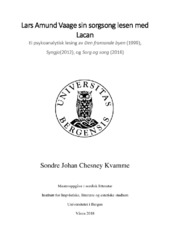| dc.contributor.author | Kvamme, Sondre Johan Chesney | |
| dc.date.accessioned | 2018-08-24T07:15:45Z | |
| dc.date.available | 2018-08-24T07:15:45Z | |
| dc.date.issued | 2018-06-16 | |
| dc.date.submitted | 2018-06-15T22:00:12Z | |
| dc.identifier.uri | https://hdl.handle.net/1956/18215 | |
| dc.description.abstract | Masteroppgåve i nordisk litteratur Institutt for lingvistiske, litterære og estetiske studium Universitetet i Bergen Våren 2018 Student: Sondre Johan Chesney Kvamme Rettleiar: Christine Hamm Tittel: Lars Amund Vaage sin sorgsong lesen med Lacan Undertittel: Ei psykoanalytisk lesing av Den framande byen (1999), Syngja(2012), og Sorg og song (2016) I denne masteroppgåva analyserer eg Lars Amund Vaage sin sorgsong i dei tre bøkene Den framande byen (1999), Syngja (2012) og Sorg og song (2016). Eg tolkar og analyserer forteljarteknikken og strukturen i bøkene i dialog med Lacan sin psykoanalyse, med eit særleg fokus på repetisjonar og erindringar. I oppgåva argumenterer eg for at det Vaage kallar for «sorgsong», er ein metode for å omarbeida og behandla eit traume. Gjentakingar av minne er ein sentral funksjon til sorgsongen for at subjektet skal kunne handtera traumet. I Den framande byen fylgjer me psykoanalytikaren Wilhelm Reich på reisa hans til Noreg. Romanpersonen er basert på den verkelege Wilhelm Reich. I Syngja fylgjer lesaren ein eg-forteljar, som også er forfattar, som har eit autistisk barn, mykje basert på forfattaren Lars Amund Vaage sitt eige liv. Sorg og song er eit essay skrive i etterkant av Syngja, der forfattaren Lars Amund Vaage skriv om skriveprosessen knytt til Syngja. Eg analyserer dei tre tekstane strukturelt og narratologisk, og deretter tolkar eg dei i ljos av Lacan sine psykoanalytiske skrifter. Eg har funne ut at det er ein stor likskap mellom dei tre romanpersonane Reich, eg-forteljaren i Syngja og Vaage. Alle tre har falt tilbake til det som Lacan kallar Det imaginære stadiet. Som eit resultat av dette har dei blitt handlingslamma. Dei tre personane lir av ei form for nevrose lik den som Lacan diagnostiserer Hamlet med i si tolking av Hamlet (Lacan 1977). Eg har funne ut at tekstane kan bli forstått som ein type sorgsong, og at utfordringa ved å akseptera tav av ulik art har satt sitt preg på Vaage sine romanar og romanpersonar. Eg har også konkludert med at Wilhelm Reich sin psykoanalyse truleg har påverka Vaage sin litterære stil meir enn han sjølv trur. Strukturen på romanane er eit direkte resultat av denne påverknaden. | en_US |
| dc.description.abstract | MA thesis in Nordic Literature Department of Linguistic, Literary and Aesthetic Studies University of Bergen, May 2018 Student: Sondre Johan Chesney Kvamme Tutor: Christine Hamm Title: Lars Amund Vaage sin sorgsong lesen med Lacan [lit. Lars Amund Vaage’s sorrowsong read with Lacan] Subtitle: Ei psykoanalytisk lesing av Den framande byen (1999), Syngja(2012), og Sorg og song (2016) [lit. A psychoanalytical reading of Den framande byen (1999, Syngja (2012) and Sorg og song (2016)] This MA thesis analyses Lars Amund Vaage’s «sorgsong» and its development in his three books Den framande byen (1999), Syngja (2012) and Sorg og song (2016). I interpret and analyse the narrative techniques and structures found in the books in dialog with Jacques Lacan’s psychoanalysis, with a focus on repetitions and recollections, or memories. In the thesis, I argue that the «sorgsong» is a method for treating and overcoming a trauma. Repetitions of memories is a central function in the “sorgsong”, as it attempts to overcome the trauma. Den framande byen is a novel about the psychoanalyst Wilhelm Reich, following him on his journey and stay in Norway. The fictional person is based on the real Wilhelm Reich. Syngja is a book about an author and his autistic daughter. The book is inspired by Vaage’s own life, as he also has a child with autism. Sorg og song is a book that reflects upon the writing processes that Vaage underwent whilst writing Syngja. In the thesis, I have found a striking similarity between the three persons Reich, the father in Syngja, and Vaage. They have all fallen back to Lacan’s Imaginary state and have thus lost parts of their language and ability to act. They all suffer from a form of neurosis similar to the one Lacan diagnoses Hamlet with in his analysis of Hamlet. (Lacan 1977) I have found that the three texts can be understood as a type of “sorgsong”. The challenges of accepting a loss, often a traumatic loss, has had a great impact on Vaage’s books and fictional persons. I have also concluded that Wilhelm Reich’s psychoanalysis possibly has affected Vaage’s literary style more than he is aware of himself. The way the books are structured is a direct result of this. | en_US |
| dc.language.iso | nno | eng |
| dc.publisher | The University of Bergen | eng |
| dc.subject | Norsk litteratur | eng |
| dc.subject | Psykoanalytisk litteraturteori | eng |
| dc.subject | Litterær analyse | eng |
| dc.subject | Hukommelse | eng |
| dc.subject | Gjentakelse | eng |
| dc.subject | Repetisjon | eng |
| dc.title | Lars Amund Vaage sin sorgsong lesen med Lacan.Ei psykoanalytisk lesing av Den framande byen (1999),Syngja(2012), og Sorg og song (2016) | eng |
| dc.title.alternative | Lars Amund Vaage's sorrowsong read with Lacan | eng |
| dc.type | Master thesis | |
| dc.date.updated | 2018-06-15T22:00:12Z | |
| dc.rights.holder | Copyright the author. All rights reserved | eng |
| dc.description.degree | Mastergradsoppgåve i nordisk | |
| dc.description.localcode | NOLISP350 | |
| dc.subject.nus | 711123 | eng |
| fs.subjectcode | NOLISP350 | |
| fs.unitcode | 11-21-0 | |
